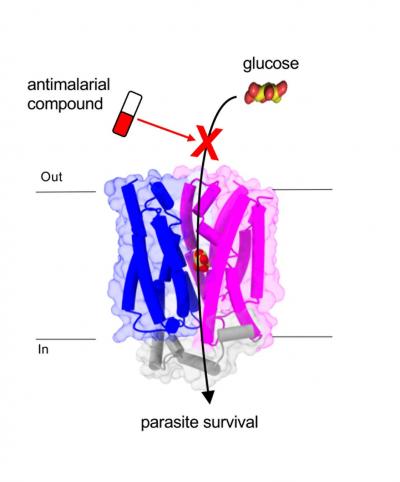Scientists discover how malaria parasites import sugar

Structure of the transport protein PfHT1 in complex with the sugar D-glucose. Credit: David Drew Usage Restrictions: The Press images are protected by copyright. Free use of the media in connection to news article or feature with connection to Stockholm University.
“By elucidating the atomic structure of the sugar-transporting-protein PfHT1, we can better understand how glucose is transported into the parasite”, says David Drew, Wallenberg Scholar at the Department of Biochemistry and Biophysics and leading the study at Stockholm University.
The main goal of the research is basic understanding of this important biological process, but with the potential for development of new antimalarial drugs. Malaria kills almost half a million persons each year, according to the WHO. By blocking the door for sugar, it has been shown that one can stop the growth of the malaria parasites.
“It's a long process from a compound with antimalarial activity to a drug that can be taken in the clinic. However, with this knowledge one can improve known antimalarial compounds so that they are more specific to the malarial transporter, so they do not have the side-effect of stopping sugar transport into our own cells. As such, this knowledge increases the likelihood that more specific compounds can be developed into a successful drug”, says David Drew.
Despite million's years of evolution between parasites and humans the research show that glucose is surprisingly captured by the sugar transporting protein in malaria parasites in a similar manner as by transporters in the human brain.
“This conservation reflects the fundamental importance of sugar uptake – basically, nature hit on a winning concept and stuck with it”, says David Drew.
However, the malaria parasite is more flexible. Other sugars, such as fructose, can also be imported. This flexibility could give a selective advantage to the malaria parasite so that it can survive under conditions when its preferred energy source glucose is unavailable.
“Every biochemistry student is taught about the process of sugar transport and it is exciting to add another important piece to this puzzle”, says Lucie Delemotte, Associate Professor of Biophysics at KTH Royal Institute of Technology and Science for Life Laboratory Fellow, who collaborated on this project.
###
The article “The molecular basis for sugar import in malaria parasites” is published in the scientific journal Nature.
The research was funded by The Knut and Alice Wallenberg foundation and Science for Life Laboratory.
Media Contact
More Information:
http://dx.doi.org/10.1038/s41586-020-1963-zAll latest news from the category: Life Sciences and Chemistry
Articles and reports from the Life Sciences and chemistry area deal with applied and basic research into modern biology, chemistry and human medicine.
Valuable information can be found on a range of life sciences fields including bacteriology, biochemistry, bionics, bioinformatics, biophysics, biotechnology, genetics, geobotany, human biology, marine biology, microbiology, molecular biology, cellular biology, zoology, bioinorganic chemistry, microchemistry and environmental chemistry.
Newest articles

NASA: Mystery of life’s handedness deepens
The mystery of why life uses molecules with specific orientations has deepened with a NASA-funded discovery that RNA — a key molecule thought to have potentially held the instructions for…

What are the effects of historic lithium mining on water quality?
Study reveals low levels of common contaminants but high levels of other elements in waters associated with an abandoned lithium mine. Lithium ore and mining waste from a historic lithium…

Quantum-inspired design boosts efficiency of heat-to-electricity conversion
Rice engineers take unconventional route to improving thermophotovoltaic systems. Researchers at Rice University have found a new way to improve a key element of thermophotovoltaic (TPV) systems, which convert heat…



